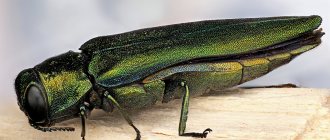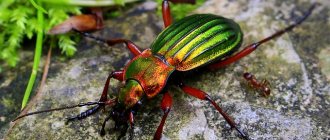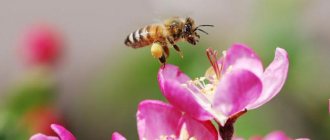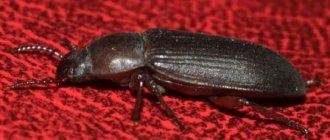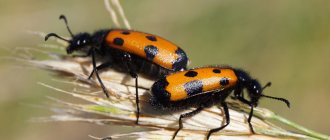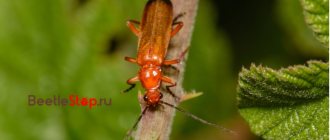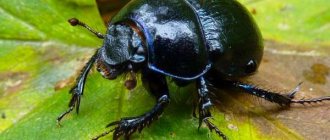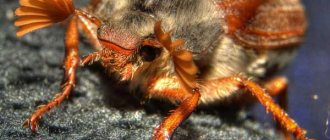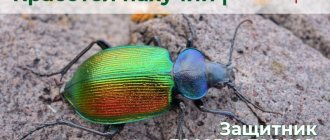The numerous family of borer beetles (Buprestidae) includes more than 15 thousand species. Insects live in all corners of the earth except the Arctic and Antarctic. The greatest variety of beetles can be found in tropical forests. 400 species of the family Buprestidae have been discovered in Russia. Representatives of most of them harm forestry and agriculture to varying degrees. Greater pine borer is a typical species that spoils pine trunks. In some regions of the Russian Federation, it was endangered and was listed in the Red Book.
Description of the insect
Appearance
The color of the pine cocoon moth varies in tone from gray-brown to brown and is similar to the color of pine bark.
The upper wings of the butterfly are grayish-brown, decorated with a red-brown stripe bordered by black jagged lines. Closer to the head, there is one clearly visible small white spot on both wings. The lower wings and body have a uniform gray-brown color. The wingspan of the female butterfly reaches 9 cm, and the male - 7 cm. In addition, the male is distinguished by the structure of the antennae, which are comb-shaped, while the female has thin thread-like antennae.
Reproduction
The pine cocoon moth is a dry-loving species and avoids damp habitats.
The most favorable places for its reproduction are dry pine forests growing at higher elevations. Butterflies begin to fly out in June and finish flying at the beginning of August.
Starting from mid-June, females lay eggs in groups of 50 on the needles, branches and bark of trees. One butterfly can lay up to 300 eggs at once. The egg stage lasts from 14 to 25 days.
In July or early August, young caterpillars emerge from the eggs and, when mature, reach 8 cm in length. The color of the caterpillars ranges from brown to ash-gray, and their hair has a reddish tint. The pine cocoon moth caterpillar can be distinguished by two dark blue velvet stripes on the second and third segments of the body.
Nutrition
The hatched caterpillars begin to feed intensively already on the second day, eating both old and young tree needles. As a rule, the needles are eaten to the ground by voracious caterpillars. In mid-autumn, caterpillars descend from trees for the winter, hiding under moss or climbing into a litter of fallen pine needles. Some individuals climb into the ground for the winter to a depth of 10 cm.
In early spring, overwintered caterpillars emerge from their hiding places, climb a tree and begin to devour old needles with renewed energy. The expanded population is mistaken for fresh buds and shoots.
In mid-June, the caterpillar reaches its final stage of development and begins to create a cocoon around itself, and then turns into a pupa. At this time, oblong gray cocoons can be seen on the needles, branches of the tree or on its bark. After about three weeks, a butterfly emerges from the cocoon. As a rule, the development of the pine cocoon moth lasts one year, but some caterpillars overwinter twice, stretching their development over two years.
Stages of pest development
Adult butterflies can appear in forests as early as the end of May, however, mass distribution usually occurs in mid-June - early July.
Mating of butterflies occurs with their appearance after the beginning of summer. After this, the female leaves eggs on the old needles, in rows of up to 32 pieces in each (usually 4-7 pieces). In the event of a mass invasion, they may appear on the needles of the current year. The average number of eggs from one butterfly is 80-230 pieces.
Development occurs within 3 weeks, but in favorable warm conditions (temperature +25 degrees) this can occur in 8 days.
Immediately after hatching, the caterpillars begin to feed. In the first stages of life, they gnaw longitudinal grooves in the needles, and later, as they grow, they jab them on both sides, but without damaging the trunk and base. In adulthood, the needles are eaten almost entirely.
REFERENCE! During its life, the moth caterpillar destroys approximately 100 needles, or 3.5 kilograms.
Feeding occurs at night. First, last year's needles are destroyed, then the caterpillars are mistaken for fresh ones, all this continues until late autumn. In October, pests descend to the ground into the litter, where pupation occurs. Wintering takes place there.
The butterflies hatch when warm weather arrives in May-early June, after which the cycle repeats.
Features of the large pine borer
To understand what the insect Chalcophora mariana is, you need to get acquainted with its features.
Head of a large pine borer
The fact is that in some regions of Russia the beetle is considered a malicious pest, in others the large pine borer is taken under protection and listed in the Red Book as an endangered species, because the harm from the large pine borer is insignificant.
Appearance of an insect
To determine the external signs of an insect, you need to get acquainted with the description of the adult beetle, the so-called imago, as well as its larvae.
Adult insects:
- The beetle attracts with its appearance. It has a shiny, dense shell that shines in the sun with a metallic bronze color with copper-green hues. The outer cover of the insect is smooth. There are beetles, inhabitants of pine forests, with purple, blue, copper and red colors.
- The body length of an adult beetle is about 22 mm. The description of the large pine borer also indicates that the body is flat, the elytra taper towards the end.
- The prothorax is motionless, the tarsus are medium-sized, five-segmented.
- The head is small, lowered down. The insect is distinguished by short serrated antennae.
- The eyes are large and complex.
- Despite the fact that the beetle has small wings, it flies quickly. This is ensured by the power of the wings. The large goldfish flies easily and quickly, although the movement is intermittent.
The male and female large pine borer, as can be seen in the photo, differ in size.
Large pine borer close-up
From eggs laid by adult females, larvae appear under the bark of a tree or in a stump:
- They are small, about 8 mm long.
- The larvae are white, flat, legs and eyes are absent.
- The head is difficult to see, because it practically merges with the prothorax. This part of the body is wide.
- At the top and bottom there are areas with spikes resembling calluses. Thanks to them, the larva moves, relying on the walls of the passages.
Life cycle and reproduction
The beetles, having passed the pupal period, come out and begin to fly from May to the end of August. The greater pine borer prefers daytime and dry, sunny weather.
Reproduction process of the great pine borer
It does not fly far from its usual habitat, its movement area is limited. The beetle settles in clearings, most often on pine trees that have been exposed to fires.
From the moment the eggs are laid until the imago emerges, it takes from 3 to 6 years.
Dimensions of large pine borer
This difference in development depends on the habitat, or more precisely, the climate. If conditions are unfavorable, the larvae do not pupate.
Female beetles choose crevices in the bark of pine trees to lay eggs. After 2 weeks the larvae appear.
Large pine borer larva
Despite their small size, the larvae are able to gnaw wide passages in the bark along the entire perimeter of the trunk.
In the passages where the larvae live, there is a wormhole. It is noteworthy that the sapwood remains intact. The larvae spend the winter where they lived in the summer. They go deeper and curl up like a horseshoe.
Pupation occurs in the spring. By mid-summer, young beetles, called adults, emerge from the pupa. To get out of the cradle, borers have to gnaw a hole in the bark.
Having got out into the wild, the beetles begin to fly around the territory. They are looking for a new shelter and feeding places. They often fly away from the pine tree where they developed over long distances.
Nutrition process and habitat
Beetles spend their entire lives on or inside trees. The large pine borer does not cause any harm to plants, since its larvae live in rotten wood and feed on it.
Chalcophora mariana on tree bark
The food of adult individuals is dying wood, pollen, nectar, and in rare cases, plant pulp. The larvae feed only on dying wood.
Cereal burrows in tree bark
You can determine that a borer has settled on a pine tree by looking at the oval-shaped holes. If the holes are round, then other insects live in the tree.
This type of beetle with a beautiful shell can be found:
- in Central and Southern Europe;
- in the Urals;
- in the southern regions of Siberia, up to Lake Baikal;
- in Western Asia;
- on the North American continent.
Coniferous forests growing on sandy soils are especially attractive to the borer.
Conclusion
Insects have excellent vision, so they manage to escape or fly to a safe place in time.
In case of danger, the goldfish can fall to the ground with its paws tucked in and pretend to be dead.
Description of the species Chalcophoramariana
The large pine borer is one of two species of the genus Chalcophora living in Russia. It is also called the large copperhead borer. Adults are the largest in size among European species. Body length 23-32 mm. Beetles are found in pine and mixed forests. Body color varies from copper-bronze to almost black. Durable body coverings with dense punctures. The head is vertical, the eyes are large and widely spaced. Insects have good eyesight and are difficult to catch by surprise. The antennae are short and serrated.
Information. In case of danger, the beetles bend their legs and antennae, and then fall from the tree, pretending to be dead.
Regrouped, with longitudinal dents and hairs. The head, thorax and elytra of beetles bear smooth longitudinal keels. On the elytra they are interrupted by four pits with a characteristic copper-green sheen. The apex of the elytra is slightly serrated; at the end they taper noticeably. Beetles have three pairs of short, strong legs. Adults move quickly on the ground and trees. Claws and spines help to stay on a vertical surface. Hard elytra completely hide the abdomen and well-developed wings. The flight of the imago is fast and easy. Sexual dimorphism is manifested in the structure of the anal sternite. The males have a copulatory organ on the last segment, and the female has a retractable ovipositor.
Fighting methods
Since the horntail grows not only in forest plantations, it can be dangerous for coniferous timber warehouses and residential buildings built from it. Infestation of the trees themselves is no less dangerous: the large horntail is capable of destroying a large area of forest, including rare conifers, and at the first sign of its appearance, measures must be taken.
The favorite delicacy of the large coniferous horntail is felled forest, so wooden houses must be treated with special compounds against insects and fungus.
Such compositions are applied with a brush or roller, and can be purchased at any hardware store. A simple spraying with Actellik can help save your garden from horntail. It should be diluted in the following proportion: 20 grams per 10 liters of water. The same substance will help get rid of other wood-eating pests.
In addition to chemicals, other insects can also get rid of the horntail population. For example, ground beetles, pests, predatory bugs or rove beetles can greatly reduce the number of parasites. You can also use the introduction of insects from the ichneumonid family, and they will parasitize the egg clutches and destroy the horntail larvae before they are born.
Finally, in nature, the large coniferous horntail becomes prey for all kinds of woodpeckers, and favorable conditions should be created for these birds to destroy the horntail in a designated forest area. This method is best for protecting trees in their natural environment.
Links
- Bukejs, Andris.
[www.zin.ru/Animalia/Coleoptera/rus/chamarlb.htm High-quality photographs of the larva of
Chalcophora mariana
] (English). ZIN RAS website (zin.ru). Retrieved August 20, 2011. [www.webcitation.org/67fn7NnTl Archived from the original on May 15, 2012]. - Kazakov, M.V.
[www.zin.ru/Animalia/Coleoptera/rus/chamarmk.htm Photos of beetles from the dorsal and thoracic sides] (English). ZIN RAS website (zin.ru). Retrieved August 20, 2011. [www.webcitation.org/67fn8BhKb Archived from the original on May 15, 2012]. - Loboda, B. M.
[www.zin.ru/Animalia/Coleoptera/rus/chamarbl.htm Photo of a beetle] (English). ZIN RAS website (zin.ru). Retrieved August 20, 2011. [www.webcitation.org/67fn8p92D Archived from the original on May 15, 2012]. - [www.barkbeetles.org/browse/subject.cfm?SUB=4223 Photo gallery. Chalcophora mariana
(Linnaeus, 1758)] (English). Bark and Wood Boring Beetles of the World website (barkbeetles.org). Retrieved August 20, 2011. [www.webcitation.org/67fn9NIdF Archived from the original on May 15, 2012].
| This is a draft article on entomology. You can help the project by adding to it. |
Phaenops-Melanophila cyanea F.
|
The blue borer prefers sparse, dry pine forests. It inhabits mainly young trees weakened by fires, diseases or excessive indiscriminate felling. During mass reproduction, it is able to settle in completely healthy, viable plantings, turning from a typical secondary pest into a primary pest.
Spreading
The habitat of this dark blue, small borer with a metallic sheen coincides with the distribution area of its main food species - pine. It can also develop on spruce, larch and cedar pines. The borer can cause serious damage to all of them.
External signs
The beetles are of medium size, their length varies between 8–12 mm. They, as befits all goldenrods, have a flat oval elongated body, which is noticeably narrowed towards the rear end; the color of the elytra varies from blue-green or bronze-green to black-blue. Their entire surface is densely covered with dots. The color of the lower part of the body is shiny green. The beetles' eyes are dark yellow.
Lifestyle
Beetles fly in midsummer. Females lay eggs one at a time in cracks and crevices in the bark of the lower part of the trunks. Colonization begins on the southern side of the trunk, usually from a height of 1–1.5 m, and gradually covers the entire middle part of the tree up to the beginning of the crown.
The larvae gnaw out flat, winding, gradually widening tunnels under the bark, which often ring the trunk. The passages are clogged with drill flour (wormholes), which lie in waves. They hardly touch the sapwood. The larvae overwinter in the thickness of the bark, curled up into a horseshoe. They pupate in spring in cradles directly in the bark (in parts of the trunk with thick bark) or in wood (in areas with transitional and thin bark). The beetles emerging from their pupae in mid-summer gnaw oval flight holes in the bark and travel through the forest, sometimes flying over considerable distances in search of the trees most suitable for colonization. The generation of the blue borer is annual; Only in the northern regions does its development slow down and can last 2 years.
Role in nature
The goldfish has few enemies. Its larvae are a favorite delicacy of woodpeckers and pikas. But are there many of these birds in the forest? A small part of the larvae is destroyed by predatory beetles that hunt under the bark. Therefore, during mass reproduction, the number of borers begins to decline only after its food resources run out, i.e. after all trees available for its colonization have been destroyed (or cut down).
Foresters are vigilantly monitoring the numbers of this beetle, well understanding the dangers of its mass reproduction.
Control measures
Control measures for blue pine borer are well known. This is, first of all, timely sampling and debarking of infested trees. In small forest areas, an effective measure is to lay out trap trees. This technique is also used to attract and catch other stem pests. It is based on the attractiveness of slightly “withered” trunks to them. Healthy trees, specially selected for this purpose, are cut down in early spring and left in the forest. Beetles emerging from their wintering places react sensitively to the attractive aroma emanating from them and flock from all over the area, rushing to be the first to take “seats in the stalls.” The population density of trap trees is sometimes surprisingly high. There is literally not a single centimeter left uninhabited on the trunk. After such an invasion, the trunks are either debarked or treated with insecticides, destroying all the beetles caught in the bait.
Lace borer family - Buprestidae
About 9 thousand species of this family are known. The fauna of golden beetles is especially richly represented in the tropical zone. There are over 400 species in Russia, including up to 140 in Ukraine, of which about 100 species are pests of trees and shrubs. Beetles are usually small and medium in size, in the fauna of Ukraine from 2.5 (Habroloma, Trackys)
up to 32 mm
(Baprestis mariana).
The body is mostly flat, elongated, tapering towards the end, often with a bright metallic color, from which the name of the family comes.
The head is small, the antennae are 11-segmented, serrated; legs are short, tarsi 5-segmented. The larvae are yellowish-white, elongated, with a flattened body. The body is almost naked or sparsely hairy, consists of a head, three thoracic and ten abdominal segments (including the anal). The head is flattened, small, retracted into the expanded prothorax. The anterior part of the head is chitinized. No eyes. The antennae are short, 3-segmented. On the dorsal chitinized area, the so-called upper shield, there are one or two longitudinal grooves converging at an angle in their anterior part. The length of the larvae ranges from 4-5 to 70 mm. The development of most borers occurs on woody and shrubby plants. Females lay eggs with a false ovipositor in cracks, crevices and under bark scales or on its smooth surface. In some species of narrow-bodied borers ( Agrilus viridis,
etc.), the egg laying is lubricated by a fluid secreted by the accessory sex glands.
Female leaf miners (Trachynae)
lay eggs on leaves, which are then mined by larvae.
The development of eggs lasts from several days to 2-4 weeks, depending on the temperature. In some species of borers, all development takes place under the bark, where the larvae make flat, sharp-edged, winding, gradually widening tunnels, tightly clogged with sandy wavy drill flour. The passages, as a rule, do not have openings to the outside and are not cleaned of drill flour by the larvae. Sometimes the passages intersect and form a characteristic tangle. Often the passages have a transverse direction and first pass through the bark and bast without touching the sapwood. In other species, development ends in the wood in a short hooked passage (such as Chrysobothris
).
The larvae of a few species feed almost all the time in wood, making long passages in stumps, dead wood, logs, buildings and technical structures. The larvae usually overwinter once, sometimes twice, and pupate in pupal cradles in the spring. The development of the pupa lasts 10-28 days. Young beetles gnaw flight holes in the shape of a more or less elongated ellipse. Beetles feed on flower pollen and leaf tissue, and representatives of the genus Capnodis
eat cuttings and shoots.
The generation is most often one or two years old. The borers inhabit mainly deciduous trees; the borer fauna of coniferous trees is relatively poor in species. In Crimea, southern steppe and forest-steppe regions, borers sometimes cause great harm. Eleven-spotted borer - Ptosima undecimmaculata
Hrbst.
South-west of the European part of Russia, Ukraine (Transcarpathian and Odessa regions), Moldova, Ciscaucasia. Mediterranean. It is noted as a pest in Bulgaria and on the island. Malta. The beetles fly from May to July. Larval passages under the bark of stone fruit branches and trunks. Acmeodera degener
Scop.
The south of the European part of Russia, in Ukraine in the Crimean and Transcarpathian regions, the Caucasus. Mediterranean, Central Europe. The summer of beetles is in July. Beetles are found on the flowers of Chrysanthemum, Hedianthemum
, etc. The larvae develop under the bark of oak branches.
Yellow-striped acmeodera borer - Acmaeodera flavofasciata
Pill.
(-A. taeniata F.)
.
The south of the European part of Russia, the Caucasus, Central Asia, Kazakhstan, Western Siberia, in Ukraine in the Crimean, Transcarpathian, Kyiv and Ternopil regions. Central Europe, Türkiye, Iran. The summer of beetles is in July. Beetles are found on yarrow flowers, some umbelliferous. The larvae develop on oak; in France they have been recorded on juniper. Flight holes are round. Antaxia polychloros
Ab.
The south of the European part of Russia, the Caucasus, in Ukraine in the steppe zone and in the mountainous Crimea. South-Eastern Europe, Türkiye, Syria. The larvae develop on oak and almond trees. Summers in June - July. The beetles are found on Asteraceae flowers. Antaxia polyphagous - Anthaxia cichorii
Ol.
The south and center of the European part of Russia, the Caucasus, Transcaucasia, in Ukraine in forest-steppe regions, Transcarpathia and the mountainous Crimea. Southern and Eastern Europe, Türkiye, Syria, Iran, Algeria. Polyphagous, the larvae develop on apple, pear, plum, cherry, oak, beech, willow, elm, buckthorn, blackberry, yellow acacia and ironwood. Summers from the second half of May to July. The beetles are found on flowers of Asteraceae and buttercups. They colonize heavily weakened and drying branches. Oak anthaxia -Anthaxia rossica
Dan.
South of the European part of Russia, Krasnodar region; in Ukraine in the forest-steppe zone and in Crimea. South-East Europe. Develops on oak. Anthaxia funerula
III.
The center and south of the European part of Russia, Western Kazakhstan, Transcaucasia; in Ukraine in forest and forest-steppe zones, sometimes in the Steppe. Central and Southern Europe, Türkiye, Syria. The larvae develop on gorse ( Genista
.), broom (recorded in Ukraine on
Cytisus zingeri
), broom grass
(Spartiam junceum L.),
panicle grass
(Sarothamnus scoparius L.),
European ulex
(Ulex europaeus L.), Calycotoma spinosa.
The beetles are found on the flowers of hawkweed
(Hieracium)
and others. They colonize drying stems and twigs.
Plum anthaxia -Anthaxia millefolii
F.
(-A. signaticollis Kryn).
South (except southeast) of the European part of Russia, North Caucasus, Transcaucasia;
in Ukraine in the forest-steppe zone, in Transcarpathia and Crimea. Balkan Peninsula, Türkiye, Syria. The larvae develop on cultivated and wild stone fruits. Summers from the second ten days of May to July. Beetles are found on the flowers of buttercups, rose hips, roses, and Asteraceae. Elm anthaxia -Anthaxia tuerki
Gnglb.
South of the European part of Russia, Samara region, floodplain of the river. Ural; in Ukraine, in places in forest-steppe regions. Central Europe (Austria, Slovakia). Develops on elm, less often on birch bark. The summer of beetles is in June. It inhabits the lower dying branches of healthy trees, where it settles together with the Kirshi sapwood (Scolytus kirshi Skal.). Anthaxia quadripunctata
L. European part of Russia, Siberia, Sakhalin;
widespread in Ukraine. Western Europe, Northern Mongolia, Northern Africa. Develops on coniferous trees (pine, spruce, fir, larch). The larvae make tunnels under the bark. The passages are long, flat, winding, gradually widening, with sharp edges, filled with variegated drill flour. They pupate in sapwood wood. The years stretch from May to August. Beetles are found along the edges, in cutting areas and forest clearings, where they visit the flowers of dandelions, buttercups, and marigolds. They colonize weakened stems and branches and unbarked timber. The generation is annual. Anthaxia godeti Cast,
et Gory.
In Russia, Voronezh and Volgograd regions, Caucasus, Ukraine (mountainous Crimea). Türkiye, Syria. Development on pines and junipers. The summer of beetles is in June. Blackish anthaxia - Anthaxia nigritula
Katz.
In Russia it is possible in the western regions of Ukraine. Europe (to the northeast to Poland and western Belarus), North Africa. The larvae develop on pine, spruce, cedar (Cedrus atlantlca),
and fir
(Abies numidica). Anthaxia mamaj
Plig.
In Russia, mountainous Crimea, northwestern Caucasus. The larvae develop on junipers. Summer occurs in May. Beetles are found on buttercup flowers. They colonize heavily weakened, drying branches. Fir anthaxia - Anthaxia helvetica
Stierl.
In Russia, Crimea, mountains of Central Europe (including the Carpathians). Development on firs and larches. Juniperus anthaxia - Anthaxia sepulchralis
F. In Russia, Ukraine, North Caucasus.
Southern and Central Europe (north to Poland), North Africa. The larvae develop on pines and other conifers. In the Stavropol Territory, damage to juniper was noted. Pine anthaxia - Anthaxia morio
F. In Russia, Belarus, the Baltic states, in Ukraine, in places in Polesie, Carpathian region and the forest-steppe part of the Donetsk region.
Western Europe. The larvae develop on pine trees, less often on spruce trees. The beetles fly in May and the first half of June. The beetles are found on the flowers of Taraxacum, Ranunculus, etc. They colonize diseased or freshly cut trees. Anthaxia brevis Cast
et Gory.
In Russia, mountainous Crimea, North Caucasus, Transcaucasia. Balkan Peninsula, Cyprus, Syria. The larvae develop on the pistachio Pistacia mutica,
as well as on scumpia and sumac.
Beetles are found on buttercup flowers. Southern anthaxia - Anthaxia croesus
Vill.
In Russia, Transcaucasia, Ukraine (southwestern regions and mountainous Crimea). Southern and Central Europe, Türkiye, Syria, Algeria. The larvae develop on maples, rowan, pear, and quince. Willow anthaxia - Anthaxia salicis
F. In Russia, Ukraine, Latvia, Transcaucasia.
Western Europe. Imported to the USA. The larvae develop under the bark of pear, apple, mountain ash, and willow. Occupies old trees. Antaxia bicolor - Anthaxia bicolor
Fald. In Russia, the Black Sea coast of the Krasnodar Territory, Transcaucasia, Central Asia, Ukraine (mountainous Crimea). Balkan Peninsula, Crete, Türkiye, Iran. The larvae develop under the bark of cherry, cherry plum, apricot, and ash. Beetles are found on rosehip and dandelion flowers, eating pollen.
BUPRESTIDAE
The amazing Russian name of the family - zlatki - accurately characterizes the main feature of most of its representatives - the bright metallic (in fact, not always golden) color of the beetles, shimmering in the sun with all the colors of the rainbow. As if knowing that they look especially beautiful in bright light, borers really love open sunny places.
In total, about 10 thousand species of borers are known in the world. Most of them live in the tropical zone of the planet, although we also have a lot of them: in Russia there are over 400. Mostly these are small and medium-sized beetles. Our largest species do not exceed 3 cm in length. But in Colombia, the beautiful giant euchroma reaches a size of 7 cm.
The body of the borer is almost cylindrical in shape, flat, elongated. The elytra are very strong. Prothorax without sharp angles. The legs are quite short and strong.
On a nice sunny summer day, borers can almost always be seen on freshly cut tree trunks, emitting a specific spicy resinous smell.
The beetles are very mobile and, as a rule, good flyers: in the midst of the midday heat they fly from trunk to trunk, quickly run along them, and bask in the sun. Goldfish have good eyesight and instantly react to danger. They are difficult to catch: when you approach the trunk on which the beetle is sitting, it instantly, like a woodpecker or a squirrel, moves away from you to the opposite side. You begin to follow him around the tree; the beetle notices your movements and again gets ahead of you, moving forward in a circle.
If you do catch the beetle, it instantly presses its legs and antennae to its body and falls to the ground. Goldweeds, like many weevils, have the ability to resort to catalepsy. In cloudy, gloomy weather, it is practically impossible to find gold borers - they are inactive and hide in secluded places.
The larvae of these beetles are worm-shaped, legless and eyeless, with the head retracted into the prothorax. Unlike the larvae of longhorned beetles, it is much wider in the larvae of golden beetles than other segments of the body. Above and below the prothorax is equipped with supporting platforms - calluses. They replace legs for the larvae. With their help, the larvae move inside the passages they gnaw in the wood.
The borers live and feed mainly on tree and shrub species - under the bark, in wood or on roots, mainly infecting dead or drying plants. But in many species, the larvae also develop in healthy wood, wearing away trunks or prepared logs and thereby causing significant harm.
The fact that the trunk is inhabited by borers can be judged by the shape of the flight holes in the wood. They are gnawed by beetles, trying to emerge from the depths of the tree trunk into the light of day. This is a clear diagnostic sign. If, for example, the bark is dotted, as if pierced by shot, with round holes from 0.5 to 4 mm in diameter, then this is a sign that the tree is damaged by bark beetles or weevils. If large (up to 7 mm) round holes are visible, these are most likely barbels or horntails. But the oval shape of the holes is evidence of the colonization of the tree by borers.
Pests of deciduous trees predominate among borers; The conifer fauna is relatively poor in species. Like bark beetles and longhorned beetles, each species prefers one or more closely related tree species and inhabits a certain part of the tree trunk, branches or roots.
The burrows of borers in wood are similar to the burrows of longhorn beetles, but are easily distinguishable from the latter by their flat shape and drill flour laid in layers. The shape of the passages is determined by the shape of the body of the larvae.
Not all types of borers have a bright color that resembles “gold”.
Insects are pests of a wooden house.
Insect pests of wood are divided into physiological pests and technical pests.
The first group lives on living plants, and the second group lives on woody building materials. There are a lot of technical pests, but among them there are those that occur most often and, therefore, require more attention. Furniture grinder. The furniture grinder can be found in any area, since this pest, as a rule, prefers to live not in the structure of the building itself, but in the furniture. Grinders damage wood of any species, but they live only in dry places, moisture is destructive for them. The size of this bug is approximately 3 mm, and it is brown in color. The bug usually begins its destructive actions by gnawing into some piece of furniture in a place where there is no paint or varnish. You can notice the presence of a grinder in furniture by the flight holes (with a diameter of 1.5 to 2 mm), from which bugs grown from larvae are released into the light. Yellow dust usually spills out of the holes themselves - this is what remains from the wood eaten by the beetle. Females often re-enter already gnawed holes in order to lay eggs inside for new generations.
Interestingly, the furniture sharpener has two nicknames associated with his behavior: “watchmaker” or “death clock”. This beetle produces sounds similar to the ticking of a clock. And although there is a superstition among people that this sound announces the imminent death of one of the inhabitants of the house, in fact, its meaning is completely different: the “ticking” sound is made by adult individuals, calling for a partner: they beat their chest shield against the wall of the passage .
House grinder
can also be found almost everywhere, but it differs in that it prefers to gnaw not furniture, but directly the parts of wooden structures themselves, and it is interested in damp wood. Unlike the furniture grinder, the brownie prefers coniferous wood, and is most often found in village baths. In addition to baths, it can be found in attics - at the ends of beams that periodically become wet from flowing water, in the kitchen, under windows and other damp corners. The beetle, as a rule, is not interested in fresh wood. The length of this grinder is from 5 to 7 mm, it has an almost black body with two golden spots of hairs. You can also find out about the presence of such a “neighbor” in the house by the presence of air holes and dust spilling out of them.
Black house beetle or woodcutter,
as it is also called. The size of this pest ranges from 7 to 21 mm, and its body color is black. Among wood, the woodcutter gives preference to coniferous trees; usually he is interested in dry, durable wood from wooden buildings that have stood for 10-15 years, and telegraph poles; this beetle rarely moves onto furniture - only in the case of active reproduction. Traces of the longhorned beetle are easy to notice - they leave behind
There are oblong holes in the wood, about 5 mm in diameter. Longhorned beetles, although they live in almost any area, prefer warmer places. These beetles have always caused the greatest harm in the Baltic states, Ukraine, southern Russia and Siberia. There were cases when these bugs, multiplying en masse, destroyed entire neighborhoods.
The rotten weevil is a member of the weevil family. Yours
it received its name due to the peculiar shape of its head, extended forward in the manner of a trunk (sometimes these bugs are also called elephant bugs). The rotten weevil has a dark brown body covered with hairs on top and a length of about 3 mm. Such bugs settle in damp wood, preferring coniferous trees. It can often be found in bathtubs, kitchens, wooden floors, and floors. As for the area of distribution, these are, as a rule, coastal towns, as well as the middle zone of the European part of Russia and Western Europe. Weevils destroy wood to the stage of rot, where it is almost impossible to find individual passages.
In order for wooden houses to last a long time and not turn into dust, you need to take care of protecting the wood during construction, when you can get to those places that will later be inaccessible.
Protecting wooden structures from woodworms
- Wood damage caused by insects
- Aboveground wood borers
- Marine wood borers
- Protective measures against woodworms
- Forestry. Insect pests.
- Pests of coniferous trees.
- Insects are pests of a wooden house.
Greater pine beetle
The beetles of the great pine beetle usually fly in late April–early May, and in early warm springs – in early April. These pests are the first to colonize weakened pines of all ages, especially in places of massive weakening, for example, in burnt areas and in areas of root fungus.
Females bore longitudinal single uterine ducts up to 23 cm long (from bottom to top) under the thick bark of the lower part of trees. Wriggling larval passages extend from them in both directions, ending in pupal cradles, which the larvae gnaw out in the thickness of the bark.
Exit openings of the greater pine beetle. Uterine passage of the greater pine beetle.
Bark beetle burrows filled with resin Tree trunk inhabited and used up by a large pine beetle
Young beetles hatching in June–July gnaw out rounded flight holes in the bark and fly into the crowns of neighboring trees for additional nutrition. They gnaw through the core of the shoots of the current year, less often of last year, as a result of which the shoots break off and fall off. When the number of beetles is high, a noticeable “haircut” of the shoots occurs, for which pine beetles are called shearers.
In autumn, the beetles leave the crowns and overwinter at the base of the trunks of living pines, making short mine passages in the thickness of the bark. The generation is annual.
“Conifer lovers” under a microscope
In order to successfully fight the enemy, you need to know him, and the better you know him, the easier it is to fight him and treat the tree. The results of the activities of all of the above pests are almost the same, but there are still some differences.
Pine aphids are grayish insects of an oblong-ovoid appearance, distinguished by strong hairiness, as for parasites. They usually sit in rows on the needles of Scots or mountain pine and suck the juices out of it, causing the needles to dry out and fall off. Aphids lay eggs on the lower surface of needles, where they overwinter. The measures to combat it are quite simple: you can wash off the aphids with a strong stream of water, you can also rinse the ends of the infected shoots in a bucket of soapy water, first covering the soil so that a large amount of soap solution does not get on the roots. The procedure must be repeated several times at intervals of 6-10 days until the parasites disappear. In the spring, you can treat the affected needles with insecticides.
Hermes are sucking dark red insects like aphids, about one millimeter long, located under the white fluff of faded needles, next to which you can see their rusty-yellow eggs. The results of the vital activity of Hermes are manifested in the shortening and fading of pine needles. In addition, they seem to “clear” the way for sooty fungi, which settle on sticky sugary smudges, spoil the “appearance” of the pine tree and infect deformed needles and shoots. It is best to remove Hermes with systemic insecticides that act on them through the sap of the plant.
The “relatives” of aphids also include coniferous insects - small insects with white fibrous shields on their backs, which serve as protection from predators. Their activity causes pine needles to turn yellow and curl. Scalebugs pose a particular danger during drought years, when they multiply in such numbers that it seems as if the branches are covered with unplanned frost. In addition to their harm, scale insects are also one of the main carriers of viruses, so their appearance on a pine tree is fraught with serious complications for it.
If the damage by scale insects is not severe, they can be destroyed by spraying the affected branches three times with tobacco infusion, which should be done at intervals of one week. If there are a lot of scale insects and the disease is in an advanced stage, systemic insecticides will come to the rescue, as in the case of Hermes, which for some time make the pine sap poisonous for pests.
It is much more difficult to remove pine scale insects - small bugs 7-10 mm in size that feed on the juices of shoots and needles, which leads to their falling off and the death of plants. The difficulty of dealing with them is that, firstly, they are covered with scutes, and secondly, they live under pine needles, so you won’t notice them right away. They fight with scale insects depending on the degree of infestation of the tree: if it is small, then the bugs can be cleaned off with an ordinary toothbrush, but if there are a lot of them, then you cannot do without the help of insecticides. Most often, akarin is used in a dosage of 30 g. for 10 l. water. Experts advise treating the tree at the moment when the larvae emerge, but the buds have not yet blossomed - that is, in May or June. The use of hunting belts made of burlap or straw is also considered an effective remedy.
The fruits of the labors of the red pine sawfly (or, as it is also called, “false caterpillar”) are visible even from afar in the form of yellow spots on the crowns of pine trees. Up close, it turns out that the needles are not just yellow, but also twisted and bitten on the sides. Microscopic, only 6-8 mm long. The larvae are dirty green in color with black flat heads and prefer to lead a group lifestyle and, in case of any threat, make frightening movements with the front part of the body. It is generally accepted that they feed only on old needles, but this is not always the case.
The fight against sawfly involves the following:
- digging up pine tree trunks.
- destruction of nests and larvae (if there are few of them).
- spraying with infusions, decoctions of insecticidal plants and insecticides.
It should be borne in mind that the eggs of the false caterpillar are characterized by amazing frost resistance and, being under the snow, can withstand winters with temperatures down to -40 degrees.
Spider mites are another insect, the results of which can often be seen in dry, hot weather in the form of a sticky web on the branches of young pine trees, which causes the needles to die and fall off. The fight against it consists of preventive spraying with cold water, infusions and decoctions of insecticidal plants, treating needles with preparations containing colloidal sulfur and pruning damaged shoots. If the area affected by the tick occupies a large area, acaricides should be used.
Pests dangerous to pine
If all the inhabitants of the kingdom of Flora were alive in the sense that we mean by this word, the pine tree would probably envy a number of indoor and garden plants that only need to be wary of a few types of pests (mealybugs, aphids, scale insects). In contrast, pine should be afraid of a whole army of parasites, just listing which can take more than one page. In addition, each part of it - wood, pine needles and even pine cones - has its own “hunters”. For example, pine needles are very loved by such representatives of the microcosm as:
- pine aphid.
- hermes.
- coniferous scale insects.
- pine scale insect.
- red pine sawfly.
- pine silkworm.
- shootweed.
- pine moth.
- pine cutworm.
- pine leaf miner.
- spider mite
Not only some animals like to feast on cones, but also cone moth and cone moth, and strong trunks are an excellent bait for such parasites as:
- pine bedbug (it doesn’t mind harming young needles at all).
- large and small pine beetle.
- pine longhorned beetle
- blue pine borer.
- pine elephant.
- spot tar.
And this is not counting various diseases such as rust and ordinary schutte...
Scale insects (Diaspididae)
Scale insects and false scale insects are frequent “guests” on thujas, junipers and yews. They are covered with a protective “shell” and look like small growths or plaques on the foliage. In females the scutes are round, up to 2 mm in diameter, while in males they are oblong. The color of the “shell” can vary from red-brown to dark brown. The greatest damage is caused by the larvae, which immediately after hatching begin to suck all the juices from the plant. Pseudoscale insects are also quite dangerous pests; their shell does not fuse with the insect’s body, and even if the shield is picked off, the parasite will remain on the plant. It is possible to determine that a tree or shrub is being attacked by scale insects by these small “growths” under which the adult insect is hiding. The needles lose their shine, turn brown, and wasps flock to the scale insects' secretions. The needles become covered with plaque, turn yellow and fall off, and the tree gradually dies.
Measures for the prevention and control of scale insects
|
We examined only the most common diseases and pests of coniferous plants, which cause maximum damage to them. In fact, there are much more of them, so you should regularly carefully inspect the plantings and take timely care of the health of your favorite plantings.
Notes
- ↑ 1234567
[www.biolib.cz/en/taxon/id9058/ Systematics and synonymy] (English). BioLib. Retrieved August 20, 2011. - Striganova B. R., Zakharov A. A.
Five-language dictionary of animal names: Insects (Latin-Russian-English-German-French) / Ed. Doctor of Biology sciences, prof. B. R. Striganova. - M.: RUSSO, 2000. - P. 135. - 1060 copies. — ISBN 5-88721-162-8. - ↑ 1 2 3
[images.bugwood.org/mediawiki/pdf.cfm?title=Archive:Atlas/Chalcophora_mariana Flatheaded pine borer (
Chalcophora mariana
)] (English) - Kolk A. and Starzyk JR 1996. The Atlas of Forest Insect Pests. The Polish Forest Research Institute. Multico Warsaw. 705 pp. - Csóka, GY & Kovács, T.
[images.bugwood.org/mediawiki/pdf.cfm?title=Archive:Xylophagus/Chalcophora_mariana Xylophagous insects] (English). — Agroinform Kiadó, Budapest: Forest Research Institute. Erdészeti Turományos Intézet., 1999. - P. 189.
Taxonomy
Ovalisia mirifica
Of the more than 15,000 species, almost 20% are in the largest genus of beetles (and possibly of all animals), Agrilus
, which describes about 3000 species. There are 95 known fossil species of borers, six of which lived in the Jurassic period.
|
|
Details about diseases caused by fungi
The causative agent of rust is the parasitic fungi Coleosporium, which settle on long-suffering needles. This disease appears in the spring, when orange-yellow vesicles filled with spores are visible on the tree. The result is yellowing of the pine needles, in which infection can persist for a long time. Some types of pine - for example, Weymouth - can be affected by rust of other types of plants - for example, black currants and gooseberries. When fighting the disease and for the prevention of those trees where its symptoms were observed, copper-containing preparations are used - “Abiga-pik”, “Kuproksat”, “Khom”, “Oksikhom”. In addition, you should avoid planting intermediate hosts of rust - currants and gooseberries - near the pine tree, and make sure that bells, sow thistle and coltsfoot do not grow next to it.
If a pine shoot is bent in the shape of the English letter S and resin-covered wounds and golden-yellow elongated swellings appear on it, from which elongated ulcers then appear, if these same swellings also affect the needles, this means that the taiga beauty has become ill with pine whirligig - an illness caused by the fungus Melampsorapinttorgua. It overwinters in the tree bark and appears in the second half of May, and with equal force it affects both seedlings and young plants up to 10 years old. You can recognize the whirlwind at the initial stage by the formation of a green bark, in which, upon close inspection, you can see white dots that turn yellow after a few days. For annual seedlings, spinner is especially dangerous and can cause mass death. To avoid illness, experts recommend the following actions:
- remove and burn fallen leaves, since in the spring basidiospores form on them, through which infection occurs.
- spray the tree with a one percent solution of Bordeaux mixture (three times), the same solution of polycarbacin or a 0.8% solution of zinebom.
- carry out injections into the tree trunk.
- use immunostimulants and microfertilizers.
The next disease - scleroderriosis (also called umbrella disease and crumenulosis) - is most dangerous for cedar, mountain and Weymouth pines and for young growth. Its causative agent is the fungus Brunchorstiapinea, whose activity can be seen in early spring:
- the bark becomes reddish-brown and hard, becomes stained and easily separates from the wood, hangs in the form of a flag or hut, after which it dries out and crumbles.
- the apical bud dies.
- Most of the young shoot is deformed, and the stems of the seedlings die off entirely or in the upper part.
Literature
- Erik Stange & Anne Sverdrup-Thygeson
[www.nina.no/archive/nina/PppBasePdf/rapport/2011/682.pdf Faglig grunnlag for handlingsplan for furupraktbille Chalcophora mariana] (Norwegian). — Kongeriket Norge: Norsk institutt for naturforskning. NINAs publikasjoner, 2011. - S. 1-21. — ISBN 1504-3312. — ISSN [www.sigla.ru/table.jsp?f=8&t=3&v0=978-82-426-2266-2&f=1003&t=1&v1=&f=4&t=2&v2=&f=21&t=3&v3=&f=1016&t=3&v4 =&f=1016&t=3&v5=&bf=4&b=&d=0&ys=&ye=&lng=&ft=&mt=&dt=&vol=&pt=&iss=&ps=&pe=&tr=&tro=&cc=UNION&i=1&v=tagged&s=0&ss=0&st =0&i18n=ru&rlf=&psz=20&bs=20&ce=hJfuypee8JzzufeGmImYYIpZKRJeeOeeWGJIZRrRRrdmtdeee88NJJJJpeeefTJ3peKJJ3UWWPtzzzzzzzzzzzzzzzbzzvzzpy5zzjzzzzzzzzzz zzzzzzzzzzzzzzzzzzzztzzzzzzbzzzzzzzzzzzzzzzzzzzzzzzzzzzvzzzzzzyeyTjkDnyHzTuueKZePz9decyzzLzzzL*.c8.NzrGJJvufeeeeeJheeyzjeeeeJh*peeeeKJJJJJJJJ JmjHvOJJJJJJJJfeeeieeeeSJJJJJSJJJ3TeIJJJJ3..E.UEAcyhxD.eeeeeeuzzzLJJJJ5.e8JJJheeeeeeeeeeeeyeeK3JJJJJJJJ*s7defeeeeeeeeeeeeeeeeeeeeeeeeSJJJJJJJZIJJzzz1..6LJJ JJJJtJJZ4….EK*&debug=false 978-82-426-2266-2] .
Causes and signs of damage
Unfortunately, gardeners do not always have the opportunity to follow absolutely all the rules for growing ornamental plants on their territory. Therefore, the causes of a certain disease or the appearance of a pest can be very different.
- High or low humidity levels. This can also include a high groundwater level, excess or lack of water.
- Insufficient soil disinfection before planting pine trees.
- Supplying shoots with low-quality fertilizers.
- Lack of preventive spring pruning of dead needles and branches.
- Lack of natural sunlight.
- Poor ventilation of internal branches due to too thick needles.
- A poorly chosen landing site is usually too low or exposed to strong winds.
- Errors when purchasing, receiving and planting seedlings, damage to the root system.
- Planting close to already infected trees.
- Insufficient soil acidity level.
If we are talking about signs of damage and disease, they can be different depending on the disease and the pest. The most basic:
- change in the appearance of needles and branches - yellowing (for example, with rust) or darkening (necrosis);
- falling of needles or branches;
- the presence of white, black or yellow plaque or blisters on tree branches;
- cobwebs or white dots on pine needles;
- detachment of bark from the tree trunk;
- the presence of holes and “paths” in the tree trunk or on the branches;
- the presence of insect colonies in the needles or between tree branches;
- gradual death of the root system or top of the tree;
- the appearance of cancerous ulcers on the tree bark.
Food goldenrod
Gold borers are stem pests. They feed on both dead and healthy wood.
Each type of borer prefers its own plant. Sometimes different representatives of beetles settle on parts of the same tree: roots, trunk, branches.
Wood eaten by pests can be identified by its appearance. If the gnawed holes have an oval shape, then the borer beetle lives here. Round holes indicate the presence of other insects.
Measures to combat moths
Although the caterpillars have already caused great damage to the tree needles, it is possible to disrupt the chain of growth at the moment the pupa transitions into a butterfly, which again produces offspring. To do this, in late autumn in infected areas, as well as for preventive purposes in a normal forest, it is recommended:
- rake coniferous and grass litter into piles;
- allow animals to pasture, such as pigs and goats, which will rake up the coniferous litter and eat the pupae, which will significantly help in the fight against moths.
Severe frosts, during which a large number of caterpillars die, help reduce the number of moths.
Helpers in the fight against moths:
- various types of ant colonies, shrews, moles and hedgehogs;
- spiders and birds helping the forest as orderlies.
In addition to the above measures, it is known that moth pupae are susceptible to fungal diseases.
Coniferous trees affected by pine moth will only be able to recover next year. This suggests that natural growth is minimal.
So, the main protective measures are as follows:
- Attract birds to plantings to help fight moths.
- Protect and protect beneficial birds.
- More often settle anthills near pine plantations.
- If there is a large number of moth pupae, it is necessary to apply treatment with a biological product or insecticide during the period of caterpillar revival (phosphorus preparations, neonicotinoids and pyrethroids).
- Apply agronomic measures: monitoring caterpillars (feces) in September and the number of pupae after the snow melts in the spring.
Where does the pest start and how does it reproduce?
As a rule, horntail appears on already cut, young or diseased trees.
It eats wood and bark. The female large coniferous horntail lays eggs in the sapwood of a tree at a depth of about 10 mm; she starts doing this 2-3 days after the op
fruitfulness. A clutch can contain from 40 to 360 eggs. For laying, the female usually chooses stunted or young trees, as well as old trunks. Up to 6–8 eggs are placed in one canal made with the help of an ovipositor, and in total the female makes about a hundred canals.
In addition to the eggs themselves, bacteria and fungal spores enter the tree, causing it to begin to rot. The eggs mature for a month, and then the larvae hatch from them, which immediately begin to eat the wood. Young larvae first damage the soft layers of wood, but as they grow, they move deeper towards the center of the tree trunk and there they turn into a pupa. This occurs in the second year of life, and the pupa spends the rest of the winter there.
Reproduction
Sawflies produce two generations per year. The first year of the imago begins in April-May, when the first clutch appears. Insects are distinguished by complete transformation. They gradually go through 4 stages:
- egg;
- larva;
- chrysalis;
- imago.
Sawfly eggs are elongated, white or greenish, oval in shape. Size – 1.6-1.7 mm. The female makes cuts in the pine needles with her ovipositor and places one egg in them. There are 6-10 pieces per needle; they are covered with a green foamy substance on top. During her life, each female lays 30-120 eggs. Adults of the first generation appear in late July and early August. They do not require food; insects immediately begin mating. False caterpillars that appear from August to October enter a winter diapause.
The larvae awaken in the spring, depending on the region in April-May. After a few days they become pupae and then adults. The development time is affected by air temperature:
- at 25°-26° - 15-25 days;
- at 13°-10° – 40-60 days
The situation demands it!
Considering the high occurrence of the ash borer in areas of mass drying of ash trees and the large area of settlement on the trunk, the total number of the pest in the foci is very high, which threatens the life of neighboring plantations with ash trees. The current situation requires a set of active protective measures against the borer.
- To localize pest outbreaks before the onset of spring, urgent sanitary felling should be carried out in all areas of massive weakening and drying of ash trees. Unfortunately, this measure is often applied very late after the borer beetles have flown out and settled; moreover, the trunks of cut trees are usually stored and lie for months in the places where they were cut down. At the beginning of summer, the overwintered larvae successfully pupate, and the opportunity is created for the emerging beetles to colonize nearby ash plantings.
- Removal and felling of trees infested with borer should be carried out before the beetles fly out, immediately after identifying infested trees, which are easily identified by pecking at the bark. It is necessary to regularly inspect all ash trees and plantings to identify foci of ash borer.
- The trunks and branches of all felled trees infested with stem insects must be removed from the felling sites before the beetles begin to fly.
- At the same time, it is necessary to tighten control over large-sized ash planting material imported into the Moscow region from foreign nurseries.
__________________________________________________
Greater pine beetle
Gold beetle in art
Lacewings' wings are used for jewelry, decoration, and even in art. Artist Jan Faber creates paintings and sculptures from the elytra of these insects. First, Faber creates a sketch on canvas, and then lays out the drawing with this natural material.
Jan Faber gets the wings of the borer beetle from Malaysian restaurants: there these insects are eaten.
In 2014, Jan Faber opened an exhibition at the PinchukArtCentre in Kyiv. There were mosaics and sculptures on display.
The artist created works of art together with his assistants. The entire exhibition took two months. Jan Faber claims that one would have to work for more than two years.
Limiting factors and threats
Stenotopic, narrowly local, consistently small species, which in the conditions of the region is due to the limited and steadily decreasing number of suitable biogeocenoses with a sufficient food supply. In this regard, known coenopopulations find themselves in practical isolation. The decline in the number of the species is caused, first of all, by cutting down and the natural decomposition of recently dried out pines, suitable for the development of larvae, and, to a somewhat lesser extent, by severe fires, although the species willingly colonizes slightly burnt pines. In the long term, disturbances in established forest ecosystems after intensive cuttings, fires and changes in the composition of plant formations, leading to a critical reduction in the food supply, are also unfavorable for the species.
